seats TOYOTA AURIS 2012 (in English) User Guide
[x] Cancel search | Manufacturer: TOYOTA, Model Year: 2012, Model line: AURIS, Model: TOYOTA AURIS 2012Pages: 750, PDF Size: 20.05 MB
Page 53 of 750
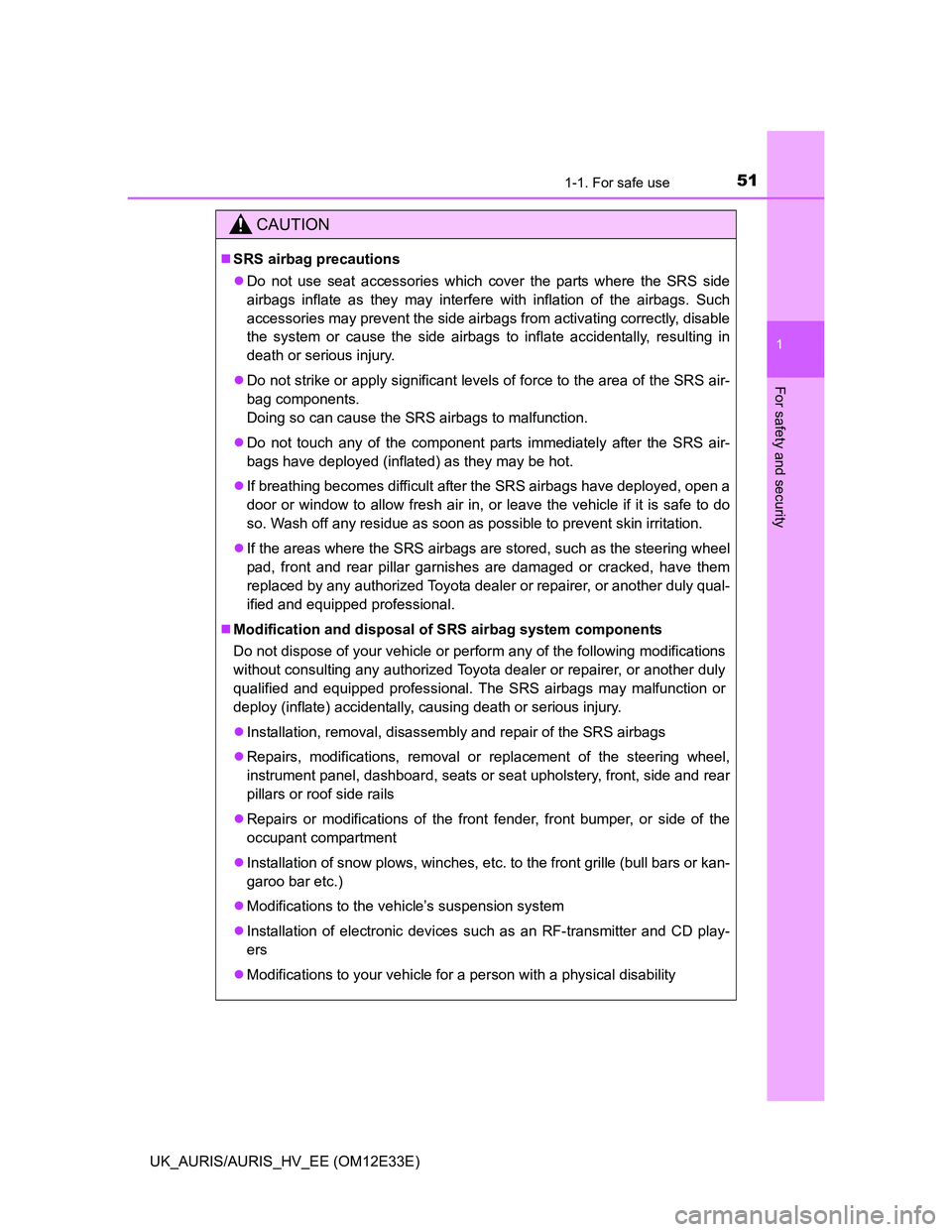
511-1. For safe use
1
For safety and security
UK_AURIS/AURIS_HV_EE (OM12E33E)
CAUTION
SRS airbag precautions
Do not use seat accessories which cover the parts where the SRS side
airbags inflate as they may interfere with inflation of the airbags. Such
accessories may prevent the side airbags from activating correctly, disable
the system or cause the side airbags to inflate accidentally, resulting in
death or serious injury.
Do not strike or apply significant levels of force to the area of the SRS air-
bag components.
Doing so can cause the SRS airbags to malfunction.
Do not touch any of the component parts immediately after the SRS air-
bags have deployed (inflated) as they may be hot.
If breathing becomes difficult after the SRS airbags have deployed, open a
door or window to allow fresh air in, or leave the vehicle if it is safe to do
so. Wash off any residue as soon as possible to prevent skin irritation.
If the areas where the SRS airbags are stored, such as the steering wheel
pad, front and rear pillar garnishes are damaged or cracked, have them
replaced by any authorized Toyota dealer or repairer, or another duly qual-
ified and equipped professional.
Modification and disposal of SRS airbag system components
Do not dispose of your vehicle or perform any of the following modifications
without consulting any authorized Toyota dealer or repairer, or another duly
qualified and equipped professional. The SRS airbags may malfunction or
deploy (inflate) accidentally, causing death or serious injury.
Installation, removal, disassembly and repair of the SRS airbags
Repairs, modifications, removal or replacement of the steering wheel,
instrument panel, dashboard, seats or seat upholstery, front, side and rear
pillars or roof side rails
Repairs or modifications of the front fender, front bumper, or side of the
occupant compartment
Installation of snow plows, winches, etc. to the front grille (bull bars or kan-
garoo bar etc.)
Modifications to the vehicle’s suspension system
Installation of electronic devices such as an RF-transmitter and CD play-
ers
Modifications to your vehicle for a person with a physical disability
Page 54 of 750
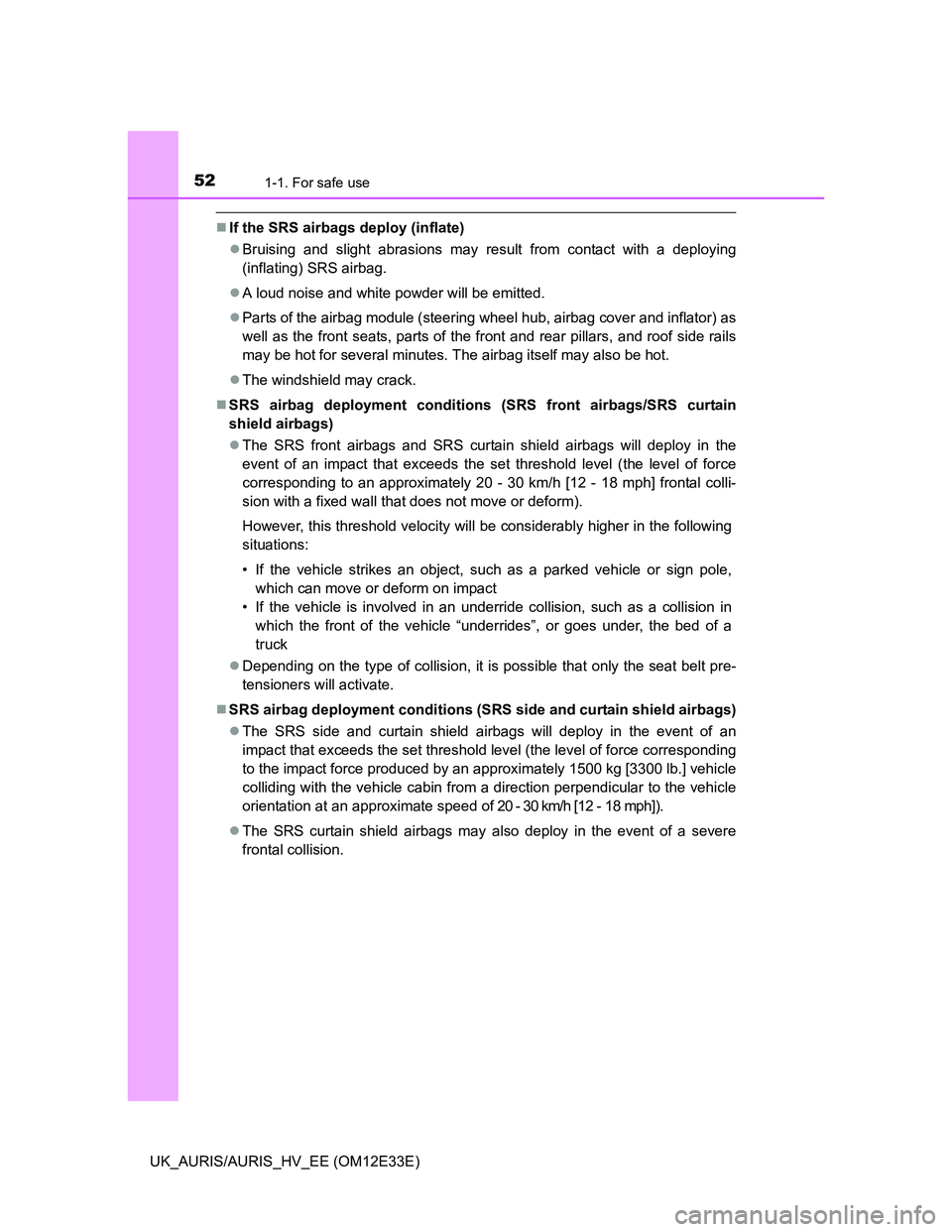
521-1. For safe use
UK_AURIS/AURIS_HV_EE (OM12E33E)
If the SRS airbags deploy (inflate)
Bruising and slight abrasions may result from contact with a deploying
(inflating) SRS airbag.
A loud noise and white powder will be emitted.
Parts of the airbag module (steering wheel hub, airbag cover and inflator) as
well as the front seats, parts of the front and rear pillars, and roof side rails
may be hot for several minutes. The airbag itself may also be hot.
The windshield may crack.
SRS airbag deployment conditions (SRS front airbags/SRS curtain
shield airbags)
The SRS front airbags and SRS curtain shield airbags will deploy in the
event of an impact that exceeds the set threshold level (the level of force
corresponding to an approximately 20 - 30 km/h [12 - 18 mph] frontal colli-
sion with a fixed wall that does not move or deform).
However, this threshold velocity will be considerably higher in the following
situations:
• If the vehicle strikes an object, such as a parked vehicle or sign pole,
which can move or deform on impact
• If the vehicle is involved in an underride collision, such as a collision in
which the front of the vehicle “underrides”, or goes under, the bed of a
truck
Depending on the type of collision, it is possible that only the seat belt pre-
tensioners will activate.
SRS airbag deployment conditions (SRS side and curtain shield airbags)
The SRS side and curtain shield airbags will deploy in the event of an
impact that exceeds the set threshold level (the level of force corresponding
to the impact force produced by an approximately 1500 kg [3300 lb.] vehicle
colliding with the vehicle cabin from a direction perpendicular to the vehicle
orientation at an approximate speed of 20 - 30 km/h [12 - 18 mph]).
The SRS curtain shield airbags may also deploy in the event of a severe
frontal collision.
Page 57 of 750
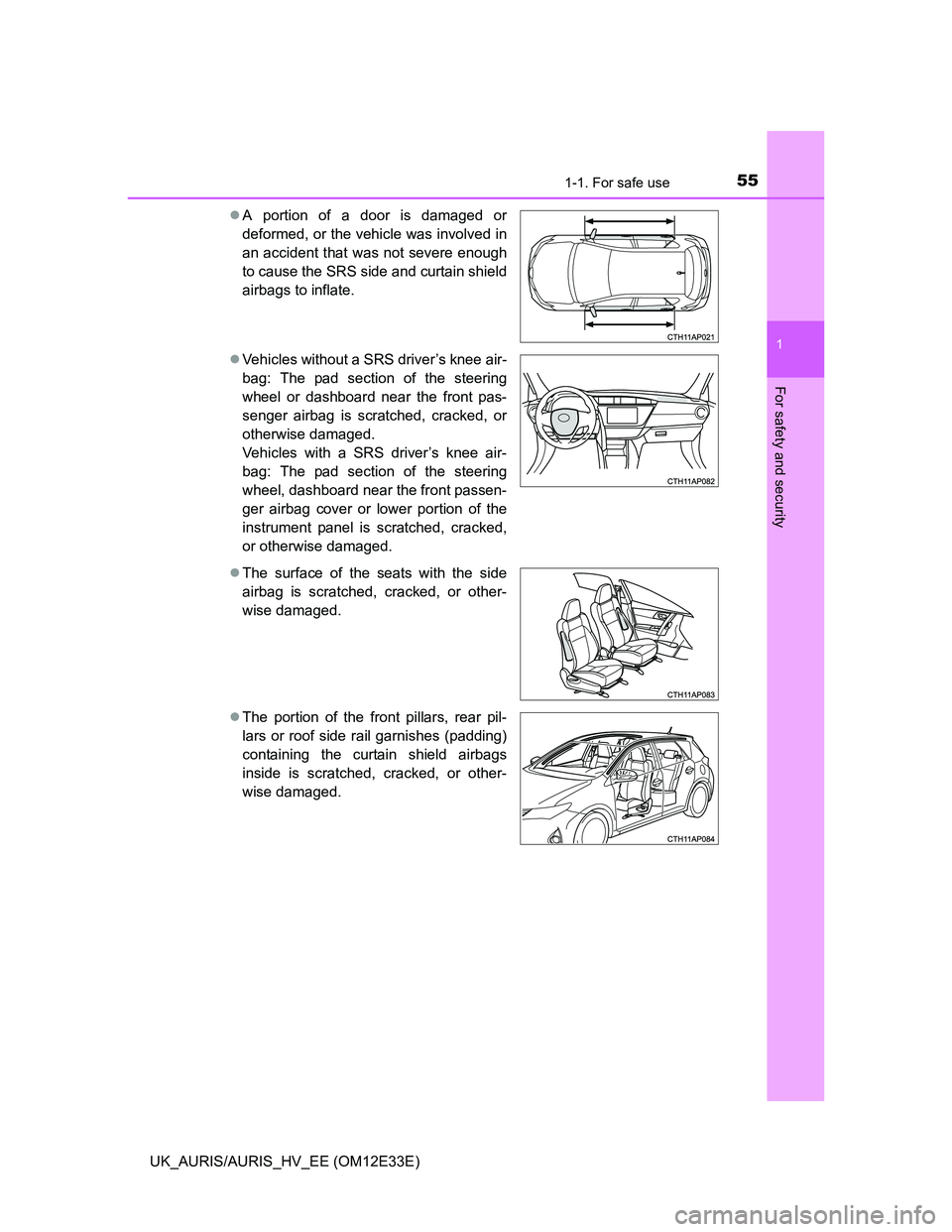
551-1. For safe use
1
For safety and security
UK_AURIS/AURIS_HV_EE (OM12E33E)A portion of a door is damaged or
deformed, or the vehicle was involved in
an accident that was not severe enough
to cause the SRS side and curtain shield
airbags to inflate.
Vehicles without a SRS driver’s knee air-
bag: The pad section of the steering
wheel or dashboard near the front pas-
senger airbag is scratched, cracked, or
otherwise damaged.
Vehicles with a SRS driver’s knee air-
bag: The pad section of the steering
wheel, dashboard near the front passen-
ger airbag cover or lower portion of the
instrument panel is scratched, cracked,
or otherwise damaged.
The surface of the seats with the side
airbag is scratched, cracked, or other-
wise damaged.
The portion of the front pillars, rear pil-
lars or roof side rail garnishes (padding)
containing the curtain shield airbags
inside is scratched, cracked, or other-
wise damaged.
Page 60 of 750
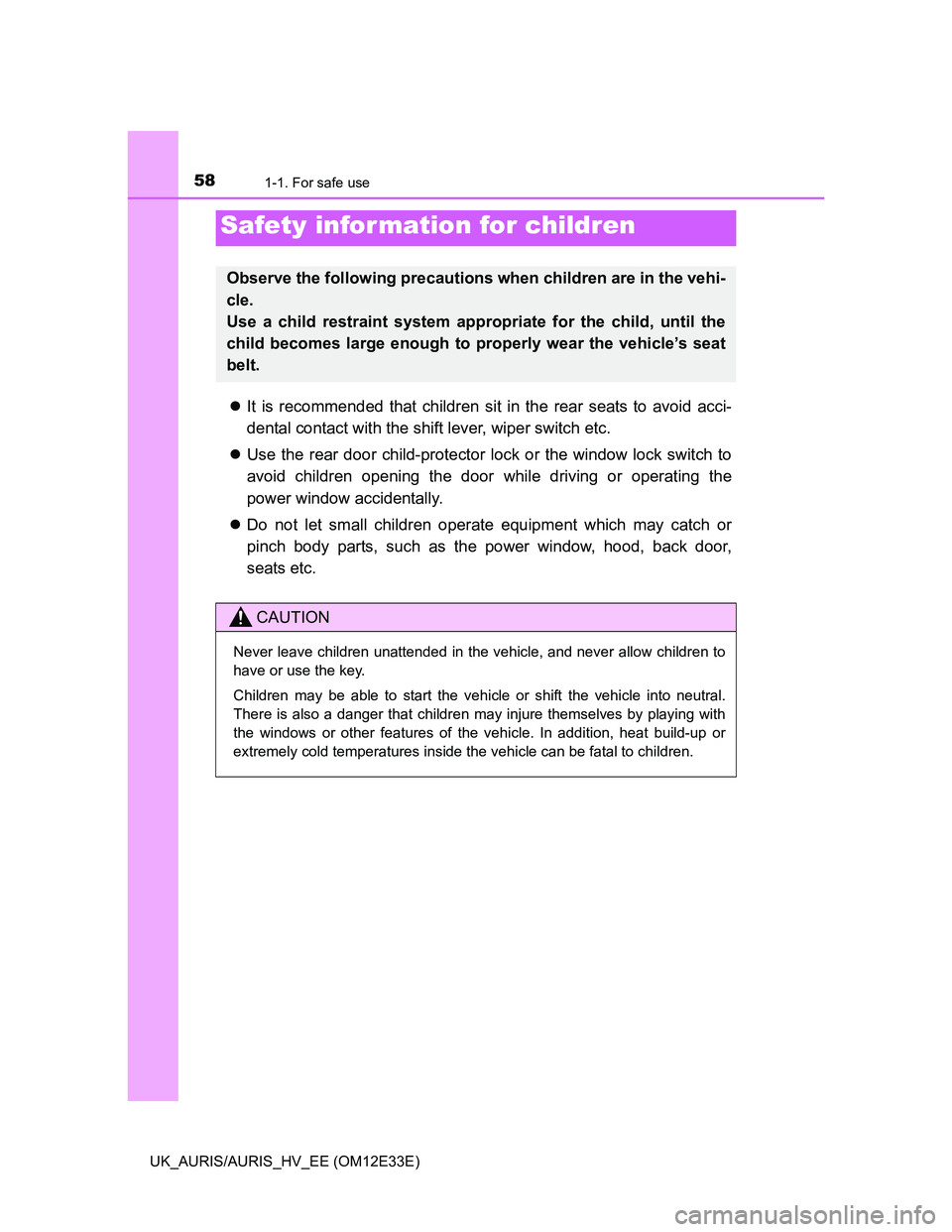
581-1. For safe use
UK_AURIS/AURIS_HV_EE (OM12E33E)
It is recommended that children sit in the rear seats to avoid acci-
dental contact with the shift lever, wiper switch etc.
Use the rear door child-protector lock or the window lock switch to
avoid children opening the door while driving or operating the
power window accidentally.
Do not let small children operate equipment which may catch or
pinch body parts, such as the power window, hood, back door,
seats etc.
Safety infor mation for children
Observe the following precautions when children are in the vehi-
cle.
Use a child restraint system appropriate for the child, until the
child becomes large enough to properly wear the vehicle’s seat
belt.
CAUTION
Never leave children unattended in the vehicle, and never allow children to
have or use the key.
Children may be able to start the vehicle or shift the vehicle into neutral.
There is also a danger that children may injure themselves by playing with
the windows or other features of the vehicle. In addition, heat build-up or
extremely cold temperatures inside the vehicle can be fatal to children.
Page 64 of 750
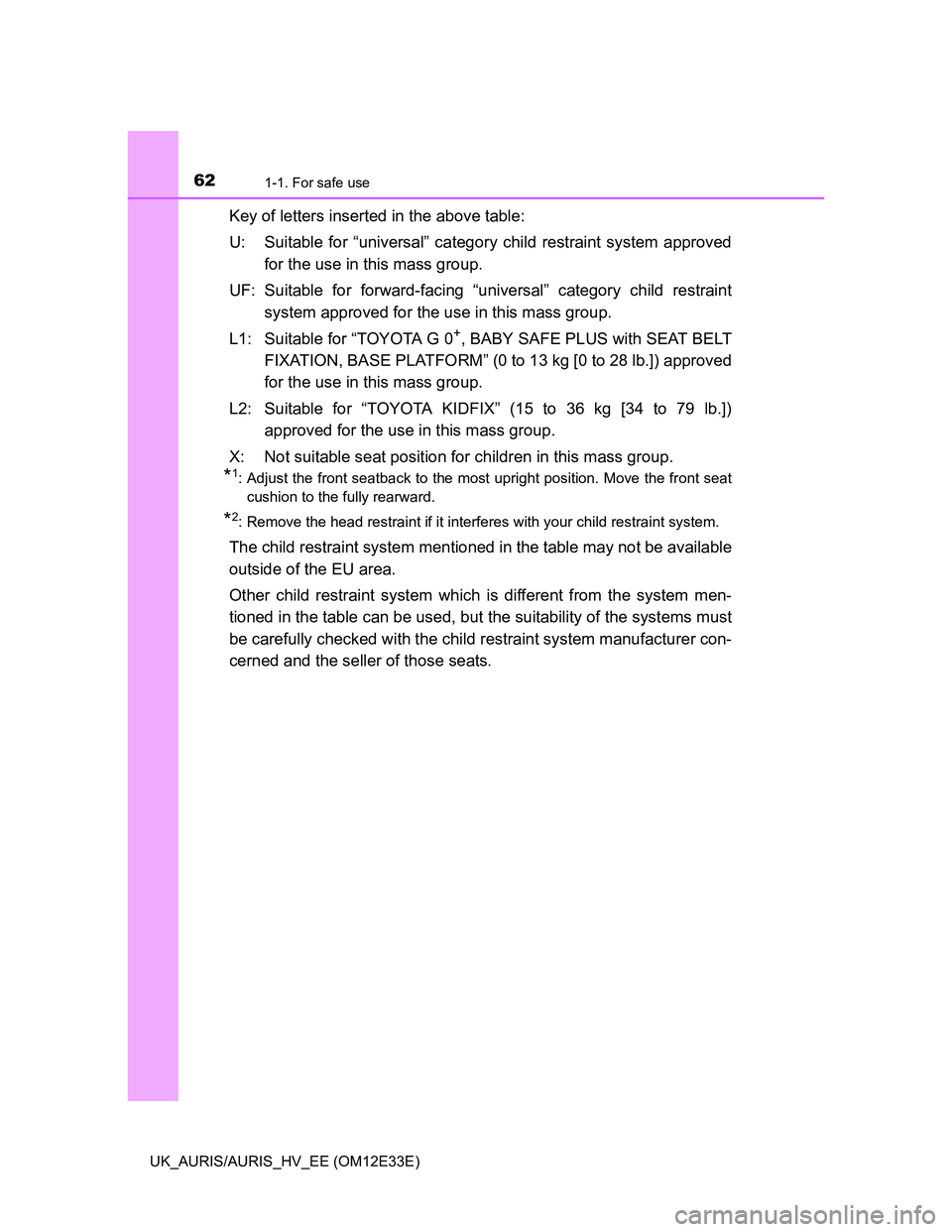
621-1. For safe use
UK_AURIS/AURIS_HV_EE (OM12E33E)
Key of letters inserted in the above table:
U: Suitable for “universal” category child restraint system approved
for the use in this mass group.
UF: Suitable for forward-facing “universal” category child restraint
system approved for the use in this mass group.
L1: Suitable for “TOYOTA G 0
+, BABY SAFE PLUS with SEAT BELT
FIXATION, BASE PLATFORM” (0 to 13 kg [0 to 28 lb.]) approved
for the use in this mass group.
L2: Suitable for “TOYOTA KIDFIX” (15 to 36 kg [34 to 79 lb.])
approved for the use in this mass group.
X: Not suitable seat position for children in this mass group.
*1: Adjust the front seatback to the most upright position. Move the front seat
cushion to the fully rearward.
*2: Remove the head restraint if it interferes with your child restraint system.
The child restraint system mentioned in the table may not be available
outside of the EU area.
Other child restraint system which is different from the system men-
tioned in the table can be used, but the suitability of the systems must
be carefully checked with the child restraint system manufacturer con-
cerned and the seller of those seats.
Page 70 of 750
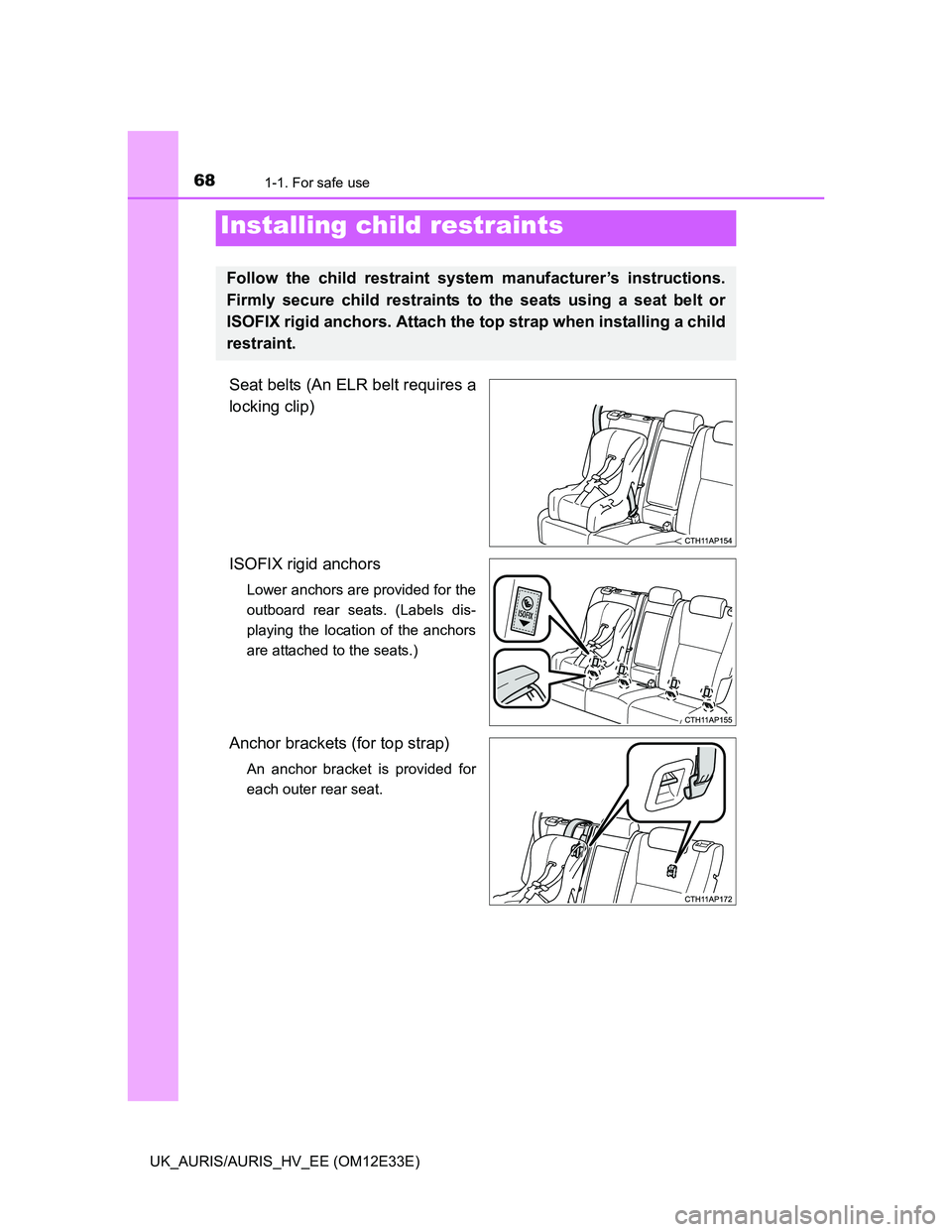
681-1. For safe use
UK_AURIS/AURIS_HV_EE (OM12E33E)
Seat belts (An ELR belt requires a
locking clip)
ISOFIX rigid anchors
Lower anchors are provided for the
outboard rear seats. (Labels dis-
playing the location of the anchors
are attached to the seats.)
Anchor brackets (for top strap)
An anchor bracket is provided for
each outer rear seat.
Installing child restraints
Follow the child restraint system manufacturer’s instructions.
Firmly secure child restraints to the seats using a seat belt or
ISOFIX rigid anchors. Attach the top strap when installing a child
restraint.
Page 85 of 750
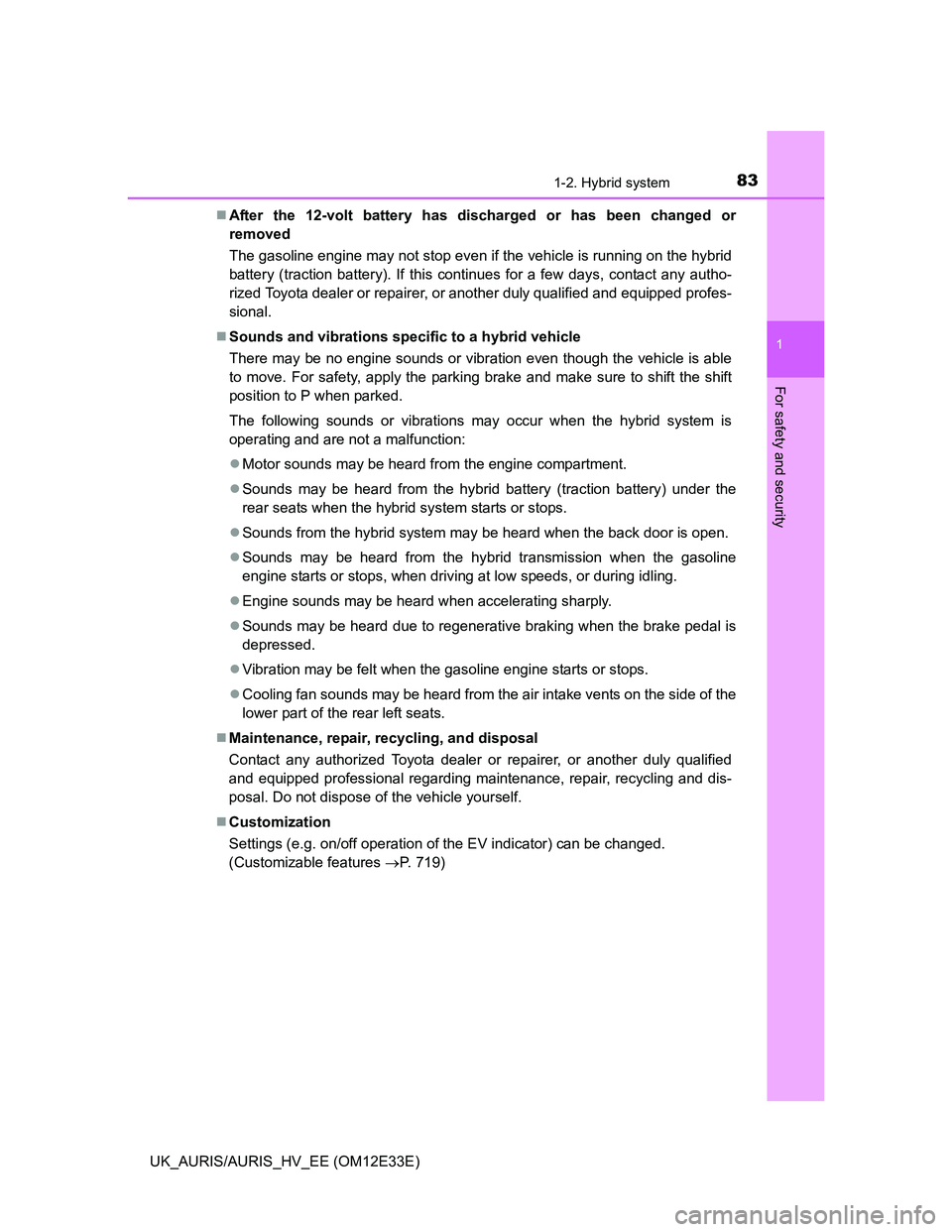
831-2. Hybrid system
1
For safety and security
UK_AURIS/AURIS_HV_EE (OM12E33E)After the 12-volt battery has discharged or has been changed or
removed
The gasoline engine may not stop even if the vehicle is running on the hybrid
battery (traction battery). If this continues for a few days, contact any autho-
rized Toyota dealer or repairer, or another duly qualified and equipped profes-
sional.
Sounds and vibrations specific to a hybrid vehicle
There may be no engine sounds or vibration even though the vehicle is able
to move. For safety, apply the parking brake and make sure to shift the shift
position to P when parked.
The following sounds or vibrations may occur when the hybrid system is
operating and are not a malfunction:
Motor sounds may be heard from the engine compartment.
Sounds may be heard from the hybrid battery (traction battery) under the
rear seats when the hybrid system starts or stops.
Sounds from the hybrid system may be heard when the back door is open.
Sounds may be heard from the hybrid transmission when the gasoline
engine starts or stops, when driving at low speeds, or during idling.
Engine sounds may be heard when accelerating sharply.
Sounds may be heard due to regenerative braking when the brake pedal is
depressed.
Vibration may be felt when the gasoline engine starts or stops.
Cooling fan sounds may be heard from the air intake vents on the side of the
lower part of the rear left seats.
Maintenance, repair, recycling, and disposal
Contact any authorized Toyota dealer or repairer, or another duly qualified
and equipped professional regarding maintenance, repair, recycling and dis-
posal. Do not dispose of the vehicle yourself.
Customization
Settings (e.g. on/off operation of the EV indicator) can be changed.
(Customizable features P. 719)
Page 149 of 750
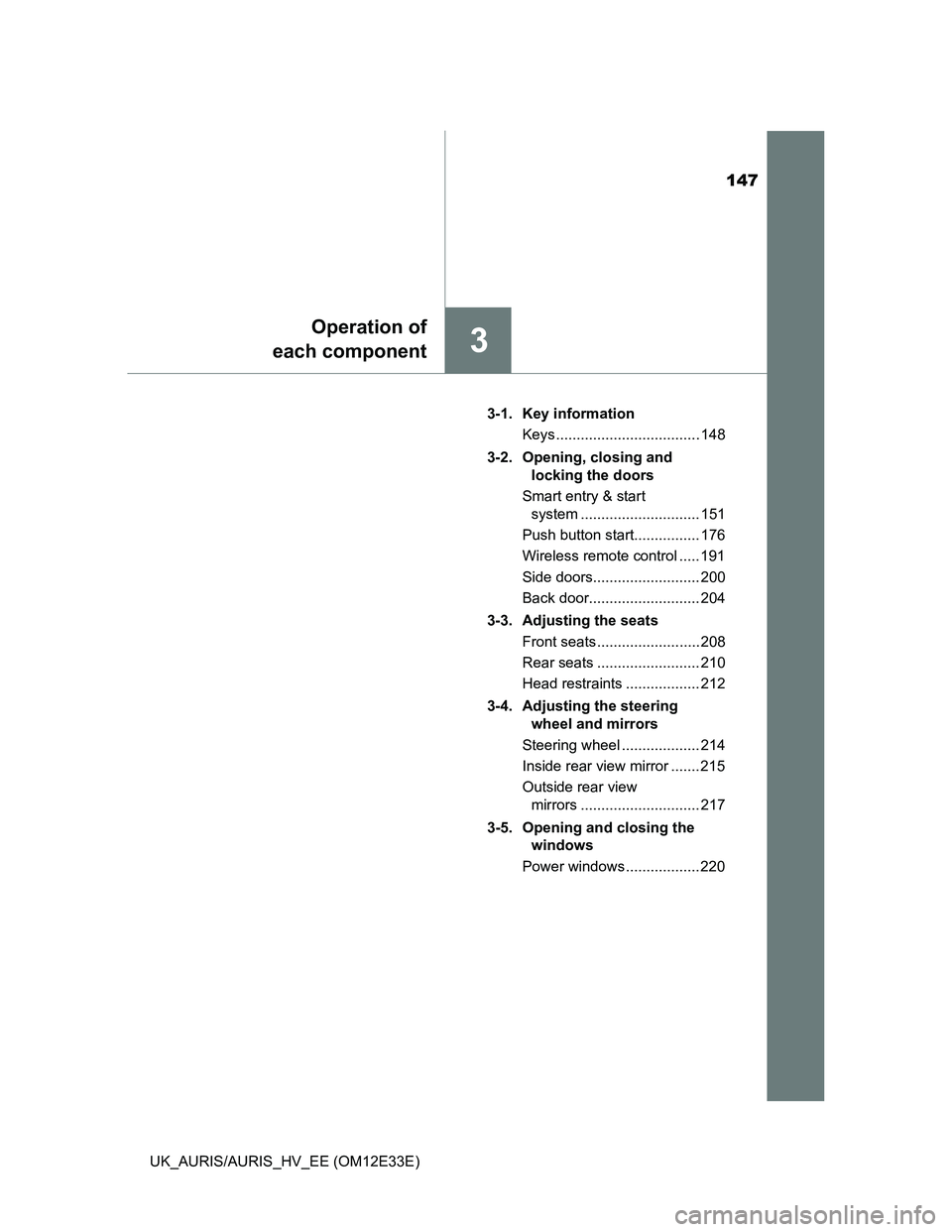
147
3
Operation of
each component
UK_AURIS/AURIS_HV_EE (OM12E33E)3-1. Key information
Keys ................................... 148
3-2. Opening, closing and
locking the doors
Smart entry & start
system ............................. 151
Push button start................ 176
Wireless remote control ..... 191
Side doors.......................... 200
Back door........................... 204
3-3. Adjusting the seats
Front seats ......................... 208
Rear seats ......................... 210
Head restraints .................. 212
3-4. Adjusting the steering
wheel and mirrors
Steering wheel ................... 214
Inside rear view mirror ....... 215
Outside rear view
mirrors ............................. 217
3-5. Opening and closing the
windows
Power windows .................. 220
Page 205 of 750
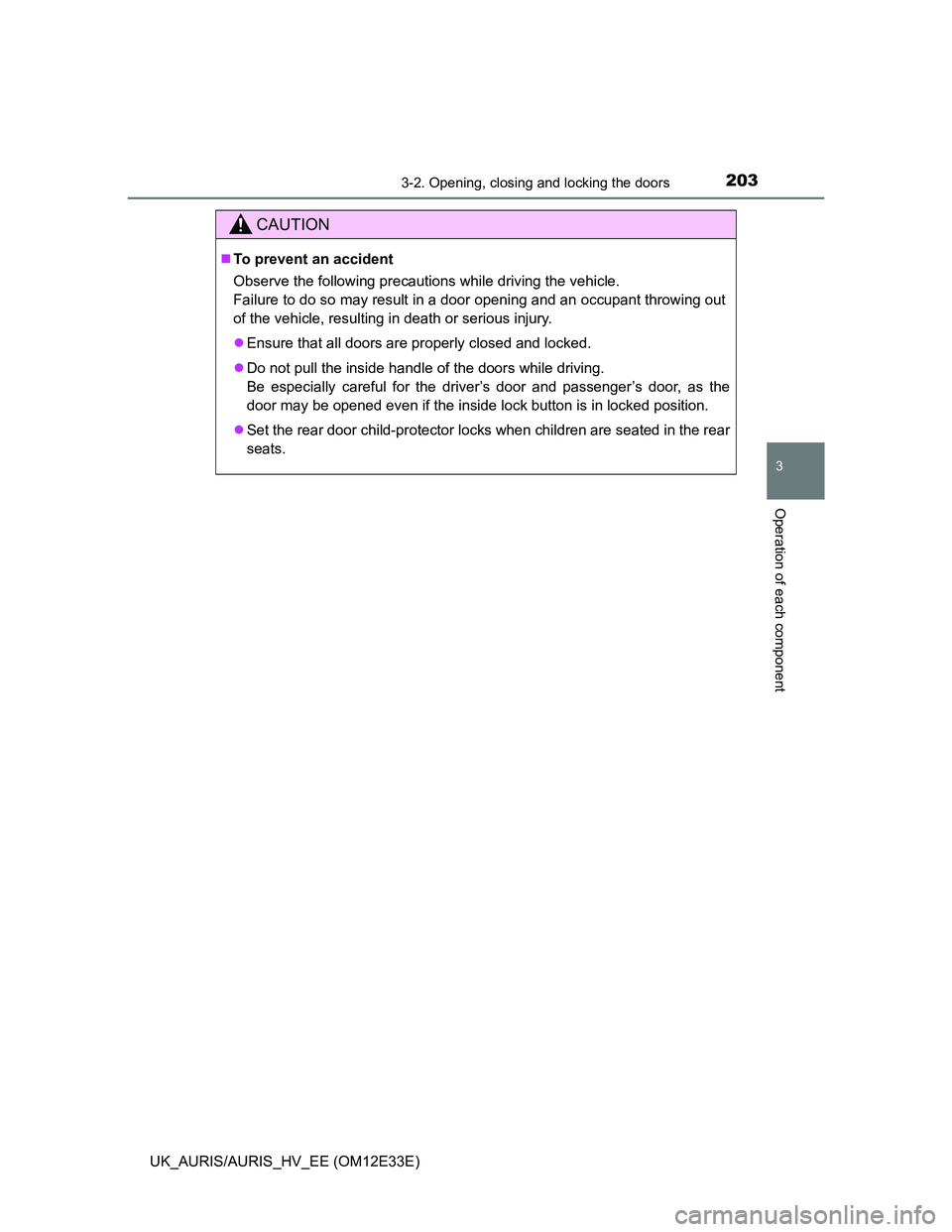
2033-2. Opening, closing and locking the doors
UK_AURIS/AURIS_HV_EE (OM12E33E)
3
Operation of each component
CAUTION
To prevent an accident
Observe the following precautions while driving the vehicle.
Failure to do so may result in a door opening and an occupant throwing out
of the vehicle, resulting in death or serious injury.
Ensure that all doors are properly closed and locked.
Do not pull the inside handle of the doors while driving.
Be especially careful for the driver’s door and passenger’s door, as the
door may be opened even if the inside lock button is in locked position.
Set the rear door child-protector locks when children are seated in the rear
seats.
Page 210 of 750
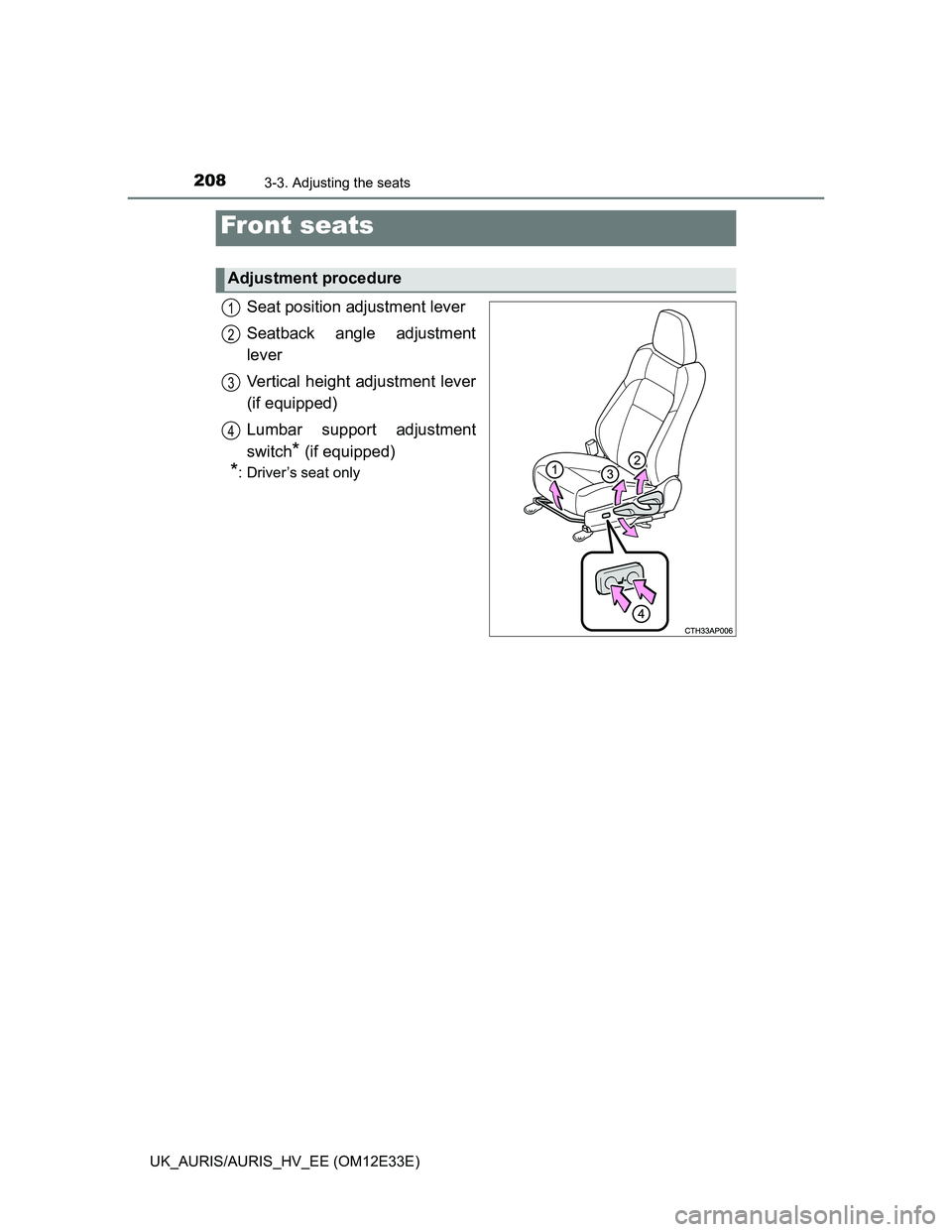
208
UK_AURIS/AURIS_HV_EE (OM12E33E)
3-3. Adjusting the seats
Seat position adjustment lever
Seatback angle adjustment
lever
Vertical height adjustment lever
(if equipped)
Lumbar support adjustment
switch
* (if equipped)
*: Driver’s seat only
Front seats
Adjustment procedure
1
2
3
4